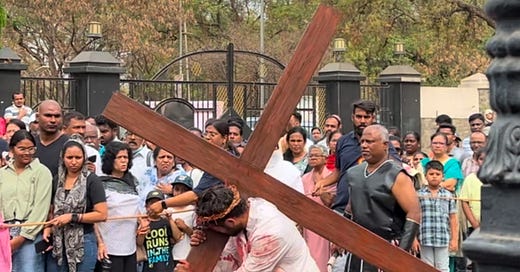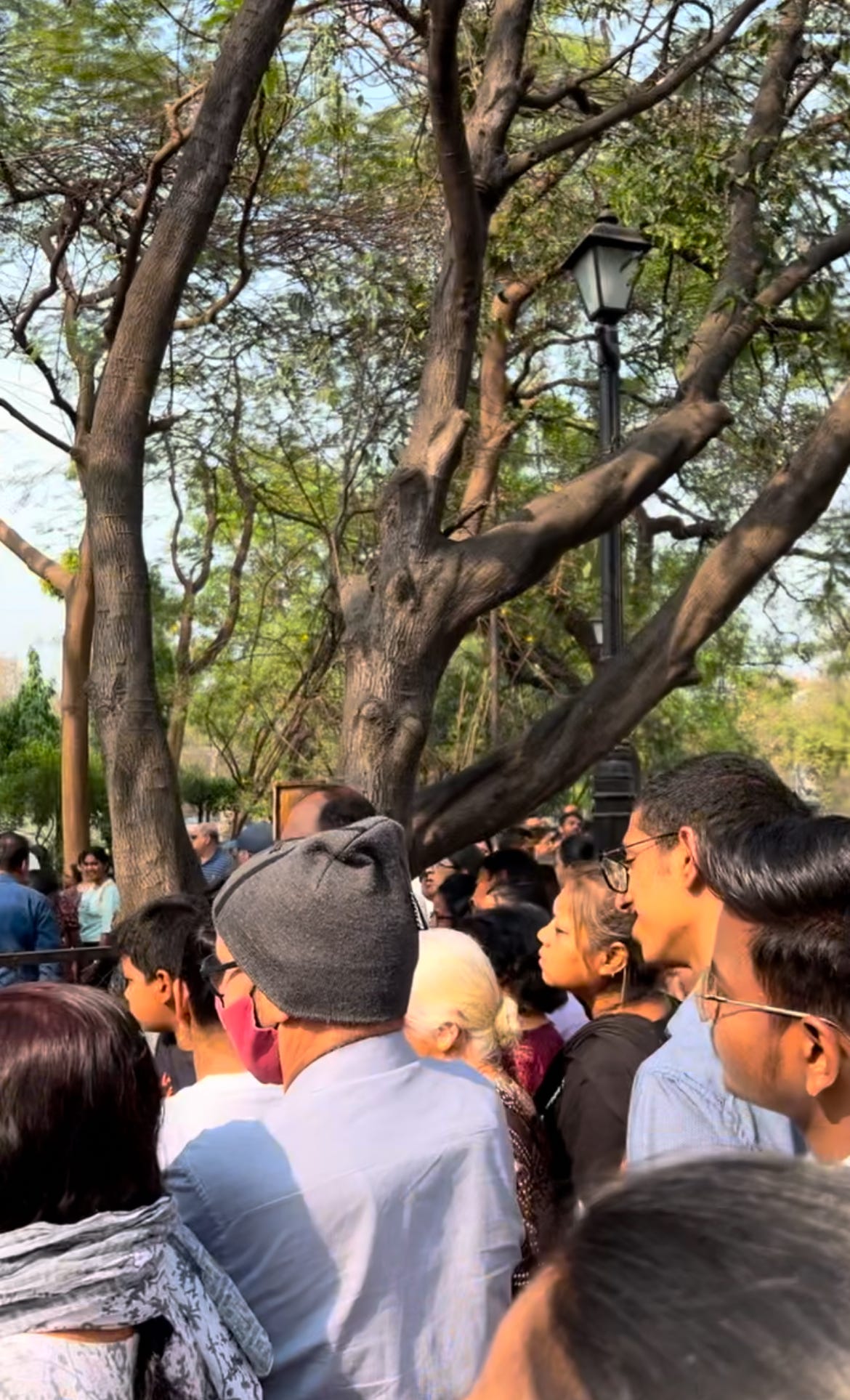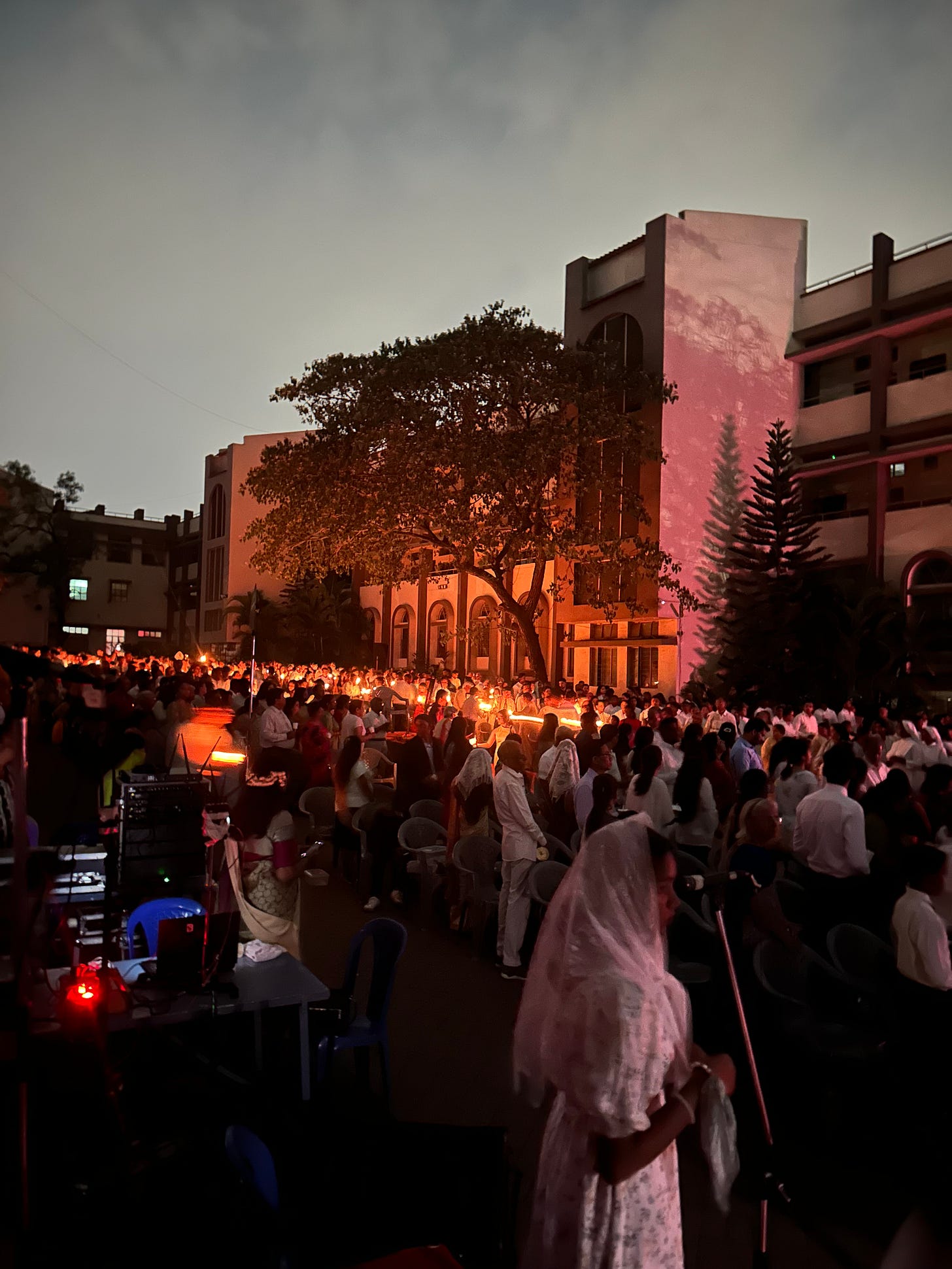Live Stations of the Cross! What a concept
For the uninitiated, a Live Stations of the Cross is where the regular stations are enacted as if they were actually occurring in real time. The depictions of the Passion narrative are usually as true to form as one can get without actually harming “Jesus”. The idea always seemed gory and dramatic to me, but last year I decided to attend, and found it unexpectedly touching.
I just got back from my second Live Stations, it being Good Friday, and was reminded of something I mostly forgot from last year: that being a part of the crowd watching the Live Stations can be its own ‘way of the cross’. The pushing, the jostling for a good view, the distraction, the irritation, the heat… all of it lends itself to a rather trying experience walking with Jesus from the Garden of Gethsemane to his Crucifixion at Calvary.
So, here are the types of people we meet (or become) at a Live Stations of the Cross, and what we can learn from them. (By the way, if you’ve never been for a Live Stations, it isn’t too different from trying to watch any performance while being in a crowd. The experience of being in a crowd, at least, is a familiar thing for any Indian.)
The Chatty Kathy’s
I’ll begin with my pet peeve, and the reason why shhhhh is the most common sound you’ll hear at a Live Stations.
These are the people who cannot stop commenting on what’s happening during the Live Stations, and giving their two cents on the matter. “Jesus’ wig is falling off, they should have chosen a better one.” “Why does Pontius Pilate look so scrawny?” “The cross should be bigger.” “The music is too loud.” And so on.
I think it’s rather instinctive for us to comment on performances, and since the Live Stations appears to be just that — a performance — we bring the same attitude. It’s frustrating, yes, but it also makes me think: surely it’s possible that some of the people who followed Jesus to Calvary had more or less the same attitude?
We know that crucifixions were a rather common, if not gory, form of Roman punishment. And so it would be within the realm of possibility for some people to have regarded Jesus’ crucifixion as a type of performance to be reviewed.
Among that crowd, of course, were some of Jesus’ disciples, including the Blessed Mother, who knew what was really happening, and were probably similarly hurt by the crowd’s cavalier attitude. And so instead of getting irritated with the Chatty Kathy’s, I could instead reflect on how it must have felt for Mary and the disciples to be amongst a crowd of them, and yet—biting their tongues—accompanied Jesus until the very end.
This also reminds me to be less of a Chatty Kathy. There’s a time and place for feedback, yes, but especially during the Holy Triduum, Jesus wants me to take full advantage of the liturgy to immerse myself in His passion, death and resurrection. Whether or not the choir is up to my standards, or the parking arrangements are as smooth as they could be, this is the time I’m meant to spend with my suffering Lord. I must resist every temptation to be one of unknowing members of that crowd, criticising the death of the Messiah.
The Push ‘n’ Shovers
Getting elbowed in the ribs is not an uncommon experience for most Indians, especially those who have travelled in the Mumbai locals at rush hour. It’s also not an uncommon occurrence at a Live Stations.
To a certain extent, I empathise with them. Because of the commitment to depicting the Stations just as they would have happened in real life, there are no stages or raised platforms used (at least in my parish). This means that the events at each Station are usually only visible to the first two or three rows of people. Obviously, this is frustrating. Especially when the crowd “ooh”s and “aah”s at something you can barely see despite being on your tippy toes.
The reality is, of course, that the thing we’re most earnest to see, the thing we want to push others aside to get closer to, is the very thing we end up flinching away from. Getting a good look at Jesus’ scars, the flogged flesh on His back, the wound in His side, only causes us to recoil. It’s a morbid dance: we want to be closer to Him, and yet we want to be shielded from the reality of His suffering.
This year, I tried to resist the temptation to push and shove my way to the front. I found myself mostly in the middle or the back of the crowd, only able to listen to what was happening on the speakers. I realised that I could still have a good reflection despite not getting to see much. And in the end, when “Jesus” was “nailed” to the cross, He was raised up and visible to everyone gathered there: the tall, the short, the push ‘n’ shovers, and the push ‘n’ shovers in recovery.
The Holy Triduum services can be stuffy, crowded, busy, and—through all of these things—annoying to sit through. Sometimes we’re stuck between elbowing our way to the front—going very early to get a good seat, cutting in line for confession—and throwing in the towel and writing the whole thing off. The truth is that God is with us, in us, during every moment of these days (and, in fact, all days). Knowing that gives us the patience to let others go before us, to give up our seat to someone in need… to realise that we do not need to “see” God to experience His presence, and we do not need to be in the front to participate.
For now we see in a mirror, dimly, but then we will see face to face. Now I know only in part; then I will know fully, even as I have been fully known. (1 Cor 13:12)
The Excited Little Kids
Today, at the first station, the little kids in front of me took off running after “Barabbas” when he was released by Pontius Pilate instead of Jesus. They were delighted by Barabbas’s wild attire and the way he roared the crowd. At the last station, a little boy behind me loudly asked his father to explain to him exactly how they were “nailing” (or tying) Jesus to the cross. He wanted to know how they were going to ensure Jesus wouldn’t fall off, and seemed very concerned that He would, and that nobody would be there to catch Him.
These instances both seemed, to me, to be a disturbance. I even darted a quick look over my shoulder at the last station, hoping to catch the little boy’s eye and gently ask him to hush, but instead I caught his father’s eye instead, who looked at me sheepishly and made me feel very embarrassed for being such a grump.
We all know that Jesus said “Let the little children come to me,” but very rarely do we realise what exactly this entails. Because little children are curious, and keep asking “why” until they get a satisfying answer. Little children are sometimes delighted by things that are supposed to be scary, accurately perceiving them to be no real threat. Their innocence and wonder challenge us, who fancy ourselves serious people. Except that Jesus asked to be like little children, and not like mean old grumps who are irritated by a little boy expressing concern for Jesus on the cross.
From the excited little kids at the Live Stations, we can learn first of all to be patient with all the excited little kids during the Holy Triduum. We can teach them reverence, of course, and encourage them to enter into the spirit of this season. But we can hardly be surprised when they cry from the heat, or take off running at the exposed cross during Holy Friday service. Instead, we can look at these holy days through their eyes, and allow ourselves to experience the liturgy afresh: mourning like it’s our very first Good Friday, and then unreservedly rejoicing at the good news of Easter Sunday.
Living the Stations of the Cross
What I learnt most of all, today, is that the Stations of the Cross isn’t something that happens in front of a crowd, that may or may not be visible to me depending on where I’m standing, and whose quality depends on the disturbances or lack thereof from the people around me. In fact, my very presence in the crowd turns into its own Stations of the Cross.
As a member of the crowd—as a member of God’s Church—I’m invited to walk the Stations with Jesus. I’m invited to bear with my neighbours, to learn from them, to let them go ahead of me, to be patient with their needs, to be inspired by them, to rely on them, to forgive them, and to love them.
And this Way is one I’m called to walk not just today, on Good Friday, but every day—
Always carrying in the body the death of Jesus, so that the life of Jesus may also be made visible in our bodies. (2 Cor 4:10)
I pray you have a Blessed Triduum!
In Christ,
Krys






